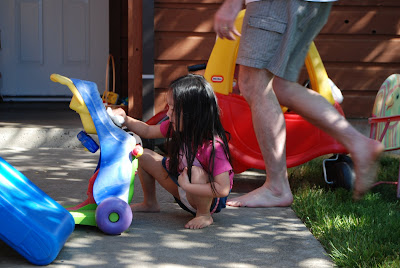First, some terminology:
Q. What is the difference in meaning between these groups of words?
* Hand dominance, handedness, and hand preference
A. Hand dominance means that one hand has the most influence or control. Handedness means that one hand is more reliable for use across a range of skillful acts. Hand preference means that one hand is preferred or chosen.
Then on to the BIG question:
Q. When does hand dominance emerge in normal development?
A. According to Dr. Arnold Gesell, the developmental progression in the first year begins with use of one hand, then the other, then alternating hands, and then using both hands together, first symmetrically (about 4 months), then one assisting the other (about 1 year). Tasks requiring each hand to perform different skilled movements develop during the preschool years and beyond. A majority of children show a preference by age 3 and most by school age, but Dr. Gesell wrote that hand dominance doesn't become well integrated in some normal children until eight or nine years of age (Gesell & Ames, 1947). It is also true that some adults demonstrate skillful ambidexterity, especially in sports.
But wait, there's more:
Q. How do left-handers compare with right-handers in functional performance, and why should we be knowledgeable about the differences?
A. A large number of research studies have found that the number of left-handers is greater in persons with learning disabilities. Even studies of individuals without disabilities show that right-handers do better than left-handers academically, but those differences are not apparent until adolescence. However, in young children, handedness is seldom found to be related to learning or problem-solving abilities (Coren, 1992). Elementary age right-handers and left-handers performed equally well on the Southern California Motor Accuracy Test (Smith, 1983). We should understand the problems experienced by normal left-handers in a primarily right-handed society (writing from left to right, using scissors, operating zippers, etc.), since so many children with disabilities have less involvement on the left side (due to greater incidence of left hemisphere damage). In other words, some of their functional problems may be due to the use of the left hand, rather than the disability.
Oh well, we have no choice but to wait this out until SS is darn well and ready.
Last evening P had a surprise for me when I came home from school. Things are slow at work, so he decided to take a day off. I was able to sleep in late (7 a.m.), and P made us a yummy breakfast with bacon, scrambled eggs and hash browns. We then sat outside for a while to settled our very full tummies. The forecast was for a high of 90. Summer is coming and we can't wait.
 While we lazy parents sat around, SS got her Spring cleaning groove on, and went to work.
While we lazy parents sat around, SS got her Spring cleaning groove on, and went to work.



 SS is loving her scooter and I am afraid she is going to break something she might need later.
SS is loving her scooter and I am afraid she is going to break something she might need later.


















No comments:
Post a Comment